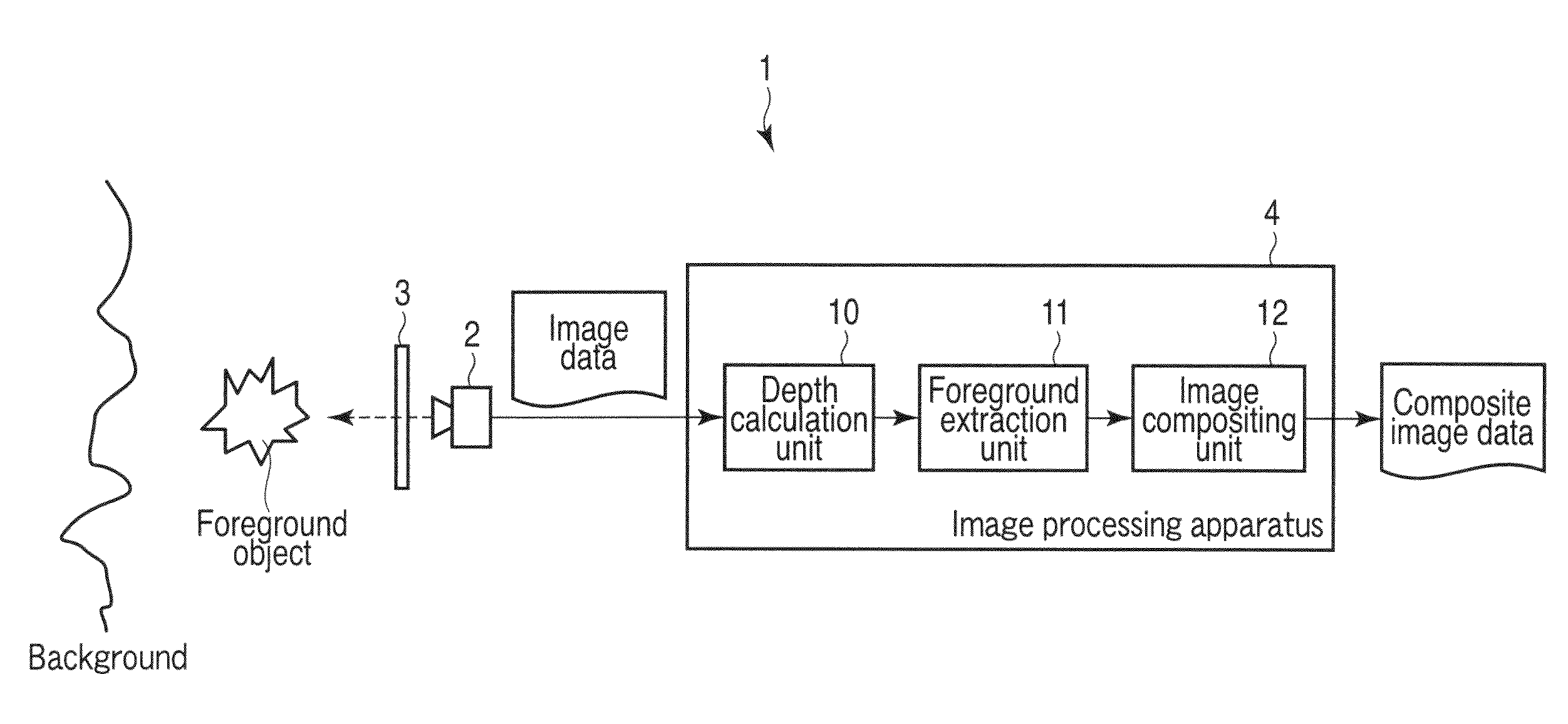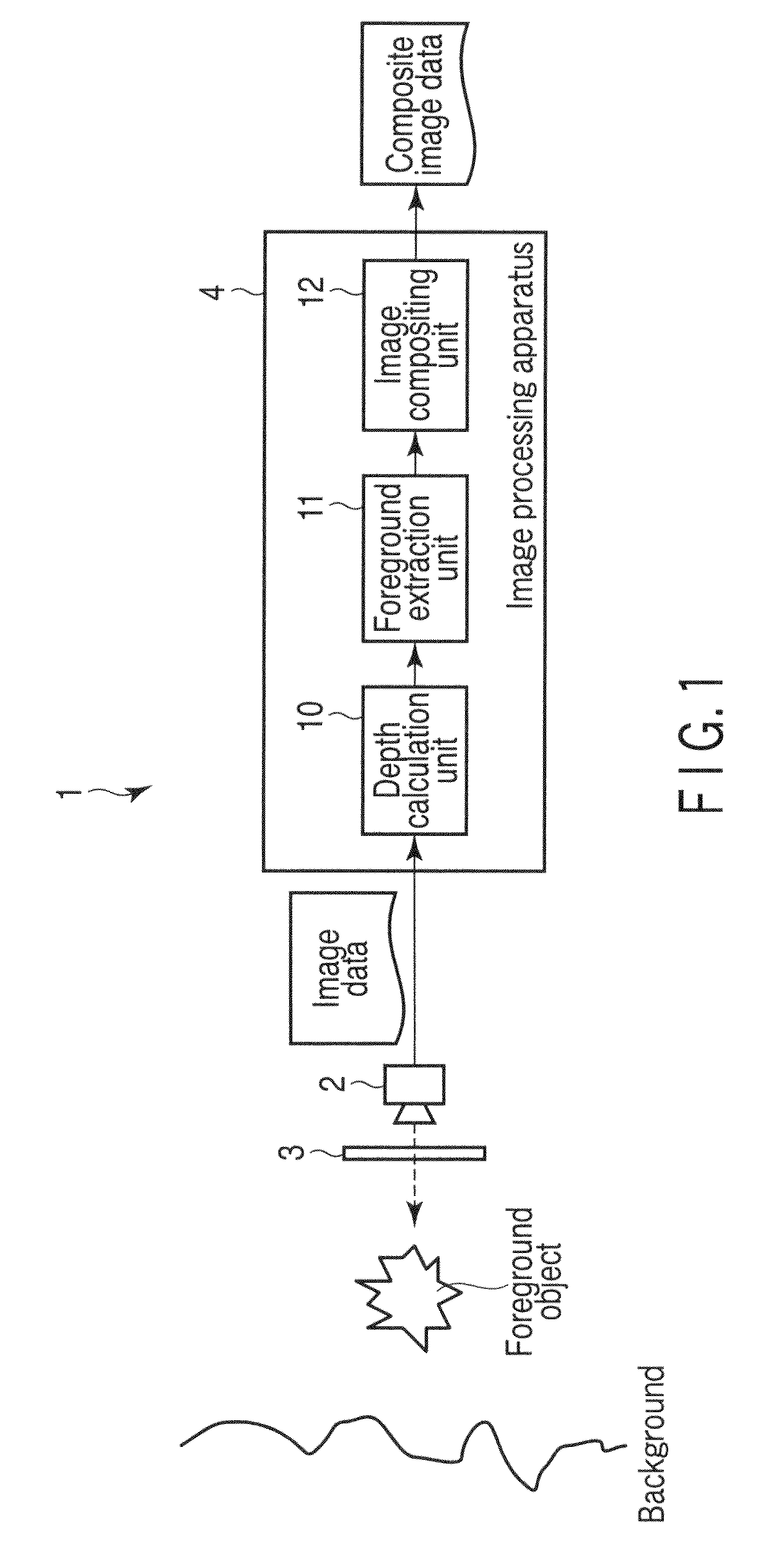Image processing Method
a processing method and image technology, applied in image enhancement, distance measurement, instruments, etc., can solve the problems of high cost, time-consuming installation of photographing equipment, and complex fabrication of cameras, and achieve the effect of sacrificing the resolution of cameras
- Summary
- Abstract
- Description
- Claims
- Application Information
AI Technical Summary
Benefits of technology
Problems solved by technology
Method used
Image
Examples
first embodiment
[0035]An image processing method according to a first embodiment of the present invention will now be described with reference to FIG. 1. FIG. 1 is a block diagram of an image processing system according to the present embodiment.
[0036]As shown in FIG. 1, the image processing system 1 includes a camera 2, a filter 3 and an image processing apparatus 4. The camera 2 photographs an object of photography (a foreground object and a background), and outputs acquired image data to the image processing apparatus 4.
[0037]The image processing apparatus 4 includes a depth calculation unit 10, a foreground extraction unit 11 and an image compositing unit 12. The depth calculation unit 10 calculates the depth in a photographed image by using the image data that is delivered from the camera 2. On the basis of the magnitude of the depth that is calculated by the depth calculation unit 10, the foreground extraction unit 11 extracts a foreground corresponding to the foreground object in the photogr...
second embodiment
[0145]Next, an image processing method according to a second embodiment of the present invention is described. The present embodiment relates to the measure at the time of using the stereo matching method, which has been described in connection with the first embodiment. In the description below, only the points different from the first embodiment are explained.
[0146]In the first embodiment, the error eline (x,y; d), which is expressed by the equation (8), is used as the measure of the stereo matching method. However, the following measures may be used in place of the eline (x,y; d).
example 1
OF OTHER MEASURES
[0147]The straight line 1 (see FIG. 9) in the three-dimensional color space of RGB is also a straight line when the straight line 1 is projected on the RG plane, GB plane and BR plane. Consideration is now given to a correlation coefficient which measures the linear relationship between two arbitrary color components. If the correlation coefficient between the R component and G component is denoted by Crg, the correlation coefficient between the G component and B component is Cgb and the correlation coefficient between the B component and R component is Cbr, the Crg, Cgb and Cbr are expressed by the following equations (16):
Crg=cov(Ir,Ig) / √{square root over ((var(Ir)var(Ig)))}{square root over ((var(Ir)var(Ig)))}
Cgb=cov(Ig,Ib) / √{square root over ((var(Ig)var(Ib)))}{square root over ((var(Ig)var(Ib)))}
Cbr=cov(Ib,Ir) / √{square root over ((var(Ib)var(Ir)))}{square root over ((var(Ib)var(Ir)))} (16)
where −1≦Crg≦1, −1≦Cgb≦1, and −1≦Cbr≦1. It is indicated that as the valu...
PUM
 Login to View More
Login to View More Abstract
Description
Claims
Application Information
 Login to View More
Login to View More - R&D
- Intellectual Property
- Life Sciences
- Materials
- Tech Scout
- Unparalleled Data Quality
- Higher Quality Content
- 60% Fewer Hallucinations
Browse by: Latest US Patents, China's latest patents, Technical Efficacy Thesaurus, Application Domain, Technology Topic, Popular Technical Reports.
© 2025 PatSnap. All rights reserved.Legal|Privacy policy|Modern Slavery Act Transparency Statement|Sitemap|About US| Contact US: help@patsnap.com



